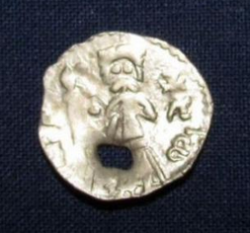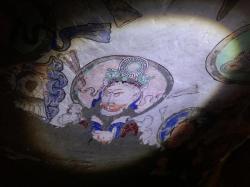INSTITUT SUPERIEUR D'ANTHROPOLOGIE
INSTITUTE OF ANTHROPOLOGY
ONLINE COURSES / COURS A DISTANCE
FALL TERM : OCTOBER 2015
REGISTER NOW
SYRIE –  Palmyre - Un nouveau drame qui fait craindre l’anéantissement de la cité antique classée au patrimoine mondial. Daesh, coutumier des actes de destructions de monuments, a réduit en poussière le célèbre Arc de triomphe de Palmyre en Syrie. En août, le groupe ultraradical avait déjà amputé Palmyre, site inscrit par l’Unesco au patrimoine mondial de l’humanité, de ses plus beaux temples, ceux de Bêl et Baalshamin, détruits à coups d’explosifs. Et en septembre, il a détruit plusieurs des célèbres tours funéraires de la cité, uniques au monde. « Nous avons reçu des informations sur le terrain selon lesquelles l’Arc de triomphe a été détruit hier (dimanche). L’EI l’a piégé il y a quelques semaines », a affirmé Mamoun Abdelkarim, le chef des Antiquités en Syrie. L’Arc de triomphe, vieux de 2.000 ans et situé à l’entrée de la célèbre rue à colonnades du site historique, « était une icône de Palmyre », a regretté le responsable. « C’est une destruction méthodique de la cité. Ils veulent la raser, la faire disparaître complètement. Nous risquons de la perdre en entier », a-t-il dit. « On sait que l’EI a encore piégé d’autres monuments. Nous avons désormais peur pour toute la cité antique. Il faut que la communauté internationale trouve le moyen de sauver Palmyre », ville qui recèle les plus beaux trésors de Syrie, a-t-il imploré.
Palmyre - Un nouveau drame qui fait craindre l’anéantissement de la cité antique classée au patrimoine mondial. Daesh, coutumier des actes de destructions de monuments, a réduit en poussière le célèbre Arc de triomphe de Palmyre en Syrie. En août, le groupe ultraradical avait déjà amputé Palmyre, site inscrit par l’Unesco au patrimoine mondial de l’humanité, de ses plus beaux temples, ceux de Bêl et Baalshamin, détruits à coups d’explosifs. Et en septembre, il a détruit plusieurs des célèbres tours funéraires de la cité, uniques au monde. « Nous avons reçu des informations sur le terrain selon lesquelles l’Arc de triomphe a été détruit hier (dimanche). L’EI l’a piégé il y a quelques semaines », a affirmé Mamoun Abdelkarim, le chef des Antiquités en Syrie. L’Arc de triomphe, vieux de 2.000 ans et situé à l’entrée de la célèbre rue à colonnades du site historique, « était une icône de Palmyre », a regretté le responsable. « C’est une destruction méthodique de la cité. Ils veulent la raser, la faire disparaître complètement. Nous risquons de la perdre en entier », a-t-il dit. « On sait que l’EI a encore piégé d’autres monuments. Nous avons désormais peur pour toute la cité antique. Il faut que la communauté internationale trouve le moyen de sauver Palmyre », ville qui recèle les plus beaux trésors de Syrie, a-t-il imploré.
http://www.20minutes.fr/monde/daesh/1701947-20151005-syrie-daesh-fait-exploser-arc-triomphe-palmyre
BULGARIE –  Kireka - Archaeologists have discovered a rare, old silver coin in Bulgaria, which was minted by Mircea the Elder – the grandfather of Vlad Dracula, whose reputation for cruelty inspired the vampire myth. The coin was found while a team was excavating the medieval monastery Kireka – which is located in the north east of the country. It is marked on one side with an image of Mircea the Elder himself, while the other side depicts what is believed to be either a Christian saint or a horseman. Similar coins have been found throughout north east Bulgaria, but this one had been pierced, although it is not thought that it had been used as part of a necklace. Mircea ruled towards the end of the 14th century and through the beginning of the next. He was thought to be the first to introduce slavery to the region when he gifted 300 people to a monastery in 1388. Speaking to Focus news agency, archaeologist Georgi Maystorski said that this coin originated from towards the end of the Kireka monastery.
Kireka - Archaeologists have discovered a rare, old silver coin in Bulgaria, which was minted by Mircea the Elder – the grandfather of Vlad Dracula, whose reputation for cruelty inspired the vampire myth. The coin was found while a team was excavating the medieval monastery Kireka – which is located in the north east of the country. It is marked on one side with an image of Mircea the Elder himself, while the other side depicts what is believed to be either a Christian saint or a horseman. Similar coins have been found throughout north east Bulgaria, but this one had been pierced, although it is not thought that it had been used as part of a necklace. Mircea ruled towards the end of the 14th century and through the beginning of the next. He was thought to be the first to introduce slavery to the region when he gifted 300 people to a monastery in 1388. Speaking to Focus news agency, archaeologist Georgi Maystorski said that this coin originated from towards the end of the Kireka monastery.
http://www.ibtimes.co.uk/dracula-cash-minted-coin-belonging-vlad-impalers-grandfather-discovered-northeast-bulgaria-1522209?
CHINE –  Xinjiang - China’s far-flung Xinjiang region may be better-known today for being the heartland of the Uighur Muslim minority, but it also has a treasure trove of Buddhist temples and art due to its location along the ancient Silk Road. The Kizil Caves in Xinjiang for instance is the earliest major Buddhist cave complex in China. Despite being uncovered in the last century, most of the caves remain closed to the public. Only top Chinese leaders are allowed to enter due to the caves’ fragile environment, but tourists can visit about eight of the other 230 known cave temples in the area, although photography’s forbidden. Most of the caves are in bad condition. “Our academy is mainly focusing on preventative protection, because there are only a few types of materials in the world that we can use to protect the sites - chemical materials,” said Xu Yongming, president of Kucha Academy of Xinjiang. “But I think these will threaten the long-term preservation of the murals.” Sun Lianqiang is one of those restoring the murals. He spends up to eight hours a day in cramped conditions touching up the artwork. “These paintings are a few thousand years old, and I feel a deep sense of responsibility, and I’m afraid of doing something wrong, so every step of the way, there’s a huge pressure,” said Sun. Some of the paintings were done as early as the 3rd century, which makes them more than 2,000 years old, so besides preserving the artwork here, the authorities are also capturing images of these artwork to form an online depository. “The main goal is still to record all the information,” said Xu. “Since 2005, we’ve done stuff like virtual tours, cave modelling and virtual modelling, so in the event that the cave is damaged, we can reconstruct it based on our online depository.”
Xinjiang - China’s far-flung Xinjiang region may be better-known today for being the heartland of the Uighur Muslim minority, but it also has a treasure trove of Buddhist temples and art due to its location along the ancient Silk Road. The Kizil Caves in Xinjiang for instance is the earliest major Buddhist cave complex in China. Despite being uncovered in the last century, most of the caves remain closed to the public. Only top Chinese leaders are allowed to enter due to the caves’ fragile environment, but tourists can visit about eight of the other 230 known cave temples in the area, although photography’s forbidden. Most of the caves are in bad condition. “Our academy is mainly focusing on preventative protection, because there are only a few types of materials in the world that we can use to protect the sites - chemical materials,” said Xu Yongming, president of Kucha Academy of Xinjiang. “But I think these will threaten the long-term preservation of the murals.” Sun Lianqiang is one of those restoring the murals. He spends up to eight hours a day in cramped conditions touching up the artwork. “These paintings are a few thousand years old, and I feel a deep sense of responsibility, and I’m afraid of doing something wrong, so every step of the way, there’s a huge pressure,” said Sun. Some of the paintings were done as early as the 3rd century, which makes them more than 2,000 years old, so besides preserving the artwork here, the authorities are also capturing images of these artwork to form an online depository. “The main goal is still to record all the information,” said Xu. “Since 2005, we’ve done stuff like virtual tours, cave modelling and virtual modelling, so in the event that the cave is damaged, we can reconstruct it based on our online depository.”
VIDEO = http://www.channelnewsasia.com/news/asiapacific/china-works-to-preserve/2167840.html?
USA –  San Antonio - San Antonio is getting a look at never-before-seen artifacts from two of the oldest sites inhabited by humans in Bexar County. New information has surfaced as a result of recent excavations at the Plaza de Armas building, where the Presidio San Antonio de Bexar was located in 1722; and at the site that's believed to be the location of the first mission San Antonio de Valero, near the Piazza de Colombo Park. These archaeological investigations are helping scientists get a better understanding of how early native Americans, Spanish colonial soldiers, settlers and missionaries lived in the area.
San Antonio - San Antonio is getting a look at never-before-seen artifacts from two of the oldest sites inhabited by humans in Bexar County. New information has surfaced as a result of recent excavations at the Plaza de Armas building, where the Presidio San Antonio de Bexar was located in 1722; and at the site that's believed to be the location of the first mission San Antonio de Valero, near the Piazza de Colombo Park. These archaeological investigations are helping scientists get a better understanding of how early native Americans, Spanish colonial soldiers, settlers and missionaries lived in the area.
http://www.mysanantonio.com/news/local/article/Newly-uncovered-artifacts-give-a-glimpse-into-San-6546844.php?#photo-8730651
CHINE - Shangzhuang - Archeologists in North China's Shanxi Province have excavated a rare turtle-shaped brick tomb dating back to about 800 years. Bai Shuzhang with the provincial institute of archaeology said on Sunday that the tomb of the mid to late Jin Dynasty (1115-1234) was discovered in April by a resident of Shangzhuang Village, Qinxian County, who was building the foundation for his new house. With a height of four meters, the tomb consists of an octagonal burial chamber and five small rooms at the chamber's northern, northeastern, northwestern, southeastern and southwestern sides. The design makes it look like a turtle from above. Inside, seven sides of the chamber are embedded with 21 brick carvings, three on each side. The works depict folk tales about filial sons. Analyses from the unearthed human remains suggest the tomb was shared by several generations of people. Bai said the tomb's shape is unusual and the brick carvings are important for research on funeral customs during the dynasty.
http://news.xinhuanet.com/english/2015-10/04/c_134683662.htm